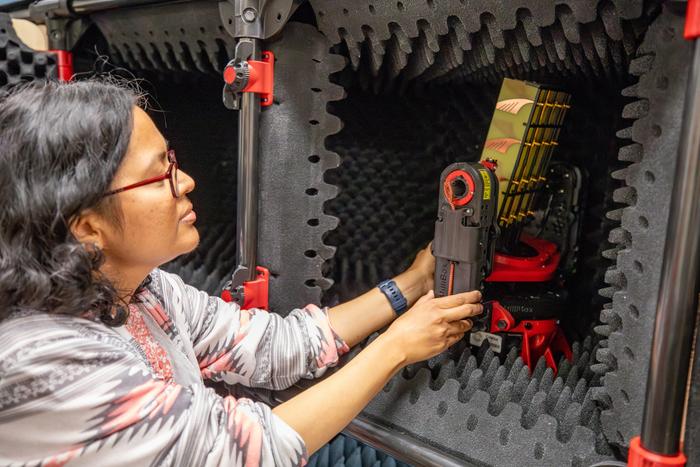Dr. Ifana Mahbub, assistant professor of electrical and computer engineering at The University of Texas at Dallas, has been awarded the Defense Advanced Research Projects Agency (DARPA) Director’s Fellowship to continue her research to develop wireless technology to recharge unmanned aerial vehicles (UAVs) in flight.

Credit: The University of Texas at Dallas
Dr. Ifana Mahbub, assistant professor of electrical and computer engineering at The University of Texas at Dallas, has been awarded the Defense Advanced Research Projects Agency (DARPA) Director’s Fellowship to continue her research to develop wireless technology to recharge unmanned aerial vehicles (UAVs) in flight.
DARPA awards the fellowships to its Young Faculty Award recipients who demonstrate exceptional performance. Mahbub received a Young Faculty Award, which provided $500,000 over two years, in 2021. The fellowship provides an additional $250,000.
Mahbub and her team of researchers are developing wireless technology to transfer electromagnetic waves to and from far distances. Called far-field wireless power transfer, or power beaming, the technology would enable UAVs, or drones, for example, to recharge without having to land at power stations. The technology would mark a significant advance in wireless recharging, which currently is limited to transferring power via low-frequency electromagnetic waves between very short distances, such as to a cellphone from a nearby charger.
“Our first goal is to deliver as much power as possible over a longer distance,” said Mahbub, a Texas Instruments Early Career Fellow and director of the Integrated Biomedical, RF Circuits and Systems Lab in the Erik Jonsson School of Engineering and Computer Science.
One of the challenges of power beaming at far distances is preventing electromagnetic waves from scattering along the way. To solve that problem, Mahbub and her team use a system of transmitters, or smaller antennas called phased-array antennas, to steer the electromagnetic waves along a targeted path.
“The signal can go in undesired directions,” Mahbub said. “Our goal is to engineer the waveform so that we can minimize the path loss.”
The technology also uses telemetry to track the movements of a UAV in real time to ensure the signal moves in the right direction.
“We can track the unmanned aerial vehicle and steer the beam to ensure we are constantly powering the dynamic vehicles,” Mahbub said. “That way, a drone going for a mission doesn’t have to return to a bay station for recharging or a battery change.”
The concept of far-field charging for UAVs applies to other technologies, too, she said, including electric vehicles, mobile phones and wearable devices. Facilitating far-field charging for vehicles or phones would involve placing transmitters in buildings and other infrastructures. Mahbub also is working on developing wireless charging technology for implanted devices that could use low-frequency electromagnetic waves at a safe level that is mandated by the Federal Communications Commission.
Mahbub’s team of researchers on the project includes electrical engineering doctoral students Adnan Patwary and Rafsan Mahin; and Dr. Sunanda Roy, postdoctoral research associate.
Mahbub, who joined UTD in 2022, received a five-year, $500,000 National Science Foundation Faculty Early Career Development Program (CAREER) Award in 2020.
Dinesh Bhatia MS’87, PhD’90, department head and professor of electrical and computer engineering, said Mahbub’s latest achievement is a point of pride for the department.
“Through her groundbreaking research on wireless charging for UAVs and her remarkable talent for fostering collaborative relationships, Professor Ifana Mahbub excels in not only the research but also the path toward innovation and teamwork in our department,” he said.



